Table of Contents
- What is Screen Mirroring?
- Methods of Screen Mirroring: Exploring the different ways you can mirror your device.
- Benefits of Screen Mirroring: How screen mirroring can enhance your productivity, entertainment, and more.
- How to Connect Your Phone to a TV: Step-by-step instructions to mirror your phone’s screen on your TV.
In today’s fast-paced digital world, the ability to easily share and display content on a larger screen is becoming more essential than ever. Whether you’re a professional giving a presentation, a teacher delivering a class, or simply someone who wants to share photos or videos with friends and family, screen mirroring can be the perfect solution. But have you ever thought about using a tablet on wheels to make this process even more seamless and mobile?
In this comprehensive guide, we’ll explain what screen mirroring is, how to set it up on different devices, and why using a tablet on wheels could be the game-changing addition to your daily life.
What Is Screen Mirroring?
Screen mirroring is a feature that allows users to project or replicate the display of their mobile phone, tablet, or computer onto a larger screen, such as a TV, projector, or monitor. This technology offers a convenient way to view content on a bigger screen without transferring files or using external storage devices.
In simple terms, screen mirroring shows exactly what’s on your device in real time, making it perfect for sharing photos, videos, presentations, and other media with others. But not all screen mirroring is created equal—there are various methods and technologies used depending on the devices and operating systems involved.
Types of Screen Mirroring
Screen mirroring can be divided into two primary categories: Wired Screen Mirroring and Wireless Screen Mirroring. Each type has its own benefits, based on convenience, ease of use, and the quality of the mirrored content.
1. Wired Screen Mirroring
Wired screen mirroring involves a physical connection between your device and the TV or display using cables, such as HDMI or USB. Although wireless solutions are growing in popularity, wired connections are still a reliable option, especially in situations where stability is important, like when giving presentations or streaming high-resolution videos.
Common Methods for Wired Screen Mirroring:
•HDMI Cable: One of the most widely used methods, connecting your phone or laptop to a TV using an HDMI cable provides a fast and high-quality mirroring experience.
•USB-C to HDMI: Many modern smartphones and laptops, especially those with USB-C ports, can connect directly to a TV via a USB-C to HDMI adapter. This allows for high-definition audio and video mirroring.
2. Wireless Screen Mirroring
Wireless screen mirroring is increasingly popular due to its convenience and ease of use. It allows users to project their screen without the hassle of cables, making it ideal for home entertainment, classroom settings, or business presentations. Wireless mirroring works via Wi-Fi or Bluetooth technologies, and there are multiple methods available depending on the devices being used.
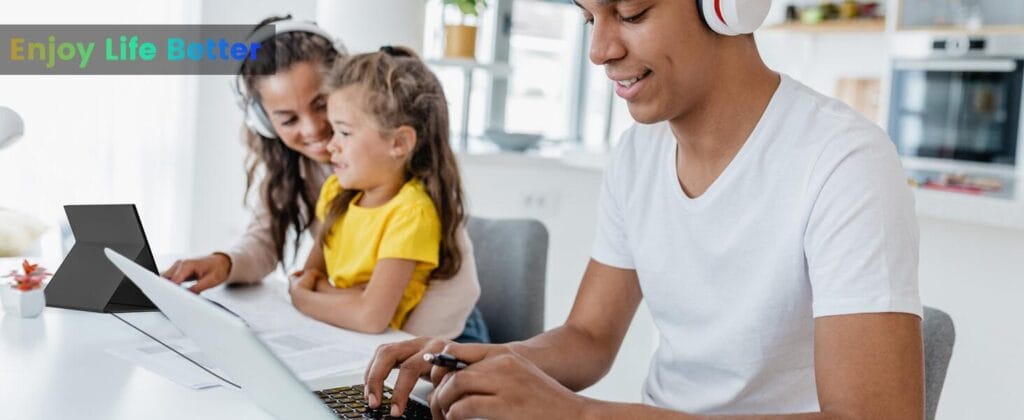
Types of Wireless Screen Mirroring
1.AirPlay (Apple Devices):
AirPlay is a proprietary technology developed by Apple that allows users to wirelessly stream audio, video, and screen content from iPhones, iPads, and Macs to an Apple TV or any AirPlay-compatible device.
How It Works: Both the Apple device and the display must be connected to the same Wi-Fi network. Users can start screen mirroring by accessing the Control Center on iPhones or iPads and selecting the Screen Mirroring option.
2.Google Cast (Android & iOS Devices):
Google Cast is a wireless mirroring technology used by Android devices, and is also compatible with iOS through the Google Home app. Chromecast devices connect to a TV’s HDMI port and allow users to cast content wirelessly from their mobile devices or computers.
How It Works: The device and the Chromecast must be on the same Wi-Fi network. Users can mirror their screens or cast media by selecting the Cast button in apps that support it.
3.Miracast (Windows & Android Devices):
Miracast is a wireless display standard that enables screen mirroring between devices without the need for a separate Wi-Fi network. It’s widely supported on Windows PCs, Android phones, and some smart TVs.
How It Works: Devices communicate directly with each other via Wi-Fi Direct. Once connected, the screen of the Android phone or Windows PC can be mirrored on the TV or monitor.
4.DLNA (Digital Living Network Alliance):
DLNA is another protocol used for streaming content wirelessly, though it’s typically more focused on media streaming (like photos, music, and videos) rather than full screen mirroring.
How It Works: Devices that are DLNA-certified can stream media directly over a local network, though it doesn’t always support real-time screen mirroring in the same way as the other technologies.
5.SmartView (Samsung Devices):
Samsung offers its own screen mirroring technology called SmartView. It allows Samsung phones to mirror content onto Samsung smart TVs wirelessly, using a simple interface.
How It Works: By enabling SmartView from the notification panel on a Samsung device, users can select the target Samsung tablet on wheels to begin mirroring.
Wired vs. Wireless Screen Mirroring: Which Should You Use?
While both wired and wireless screen mirroring methods have their advantages, the best choice depends on the specific situation:
•Wired Mirroring is ideal for scenarios where a stable and high-quality connection is required, such as business presentations or home theater setups. Wired options like HDMI and USB-C to HDMI are often more reliable for streaming high-definition content without interruptions.
•Wireless Mirroring, on the other hand, provides flexibility and mobility, making it great for casual home use, classrooms, and workplaces where multiple devices might need to connect to the same display. It’s less cluttered and more convenient, though it can be subject to lag or connection drops if the Wi-Fi signal is weak.
Benefits of Screen Mirroring
Screen mirroring provides a wide range of benefits in different settings—whether it’s at home, in the classroom, or at work. Here are some of the key advantages:
1. Enhanced Viewing Experience
One of the most common reasons for screen mirroring is to enhance the media viewing experience. By mirroring your smartphone or tablet screen onto a larger display, you can:
- Enjoy movies, videos, and games on a big screen.
- Share photos or videos with friends and family without crowding around a small device.
- Stream content from apps that may not be directly available on your TV,such as social media videos or specicialized streaming services.
2. Improved Productivity
Screen mirroring is an essential tool in professional and educational environments. Here’s how it can boost productivity:
- Presentations: Present slides, graphs, or other content directly from your phone or tablet without the need for a laptop.
- Remote Work: Host meetings or collaborate with colleagues by casting your video calls, documents, or spreadsheets onto a larger display.
- Classrooms:Teachers can easily mirror educational content from a tablet onto a projector or smartboard,making lessons more interactive and engaging.
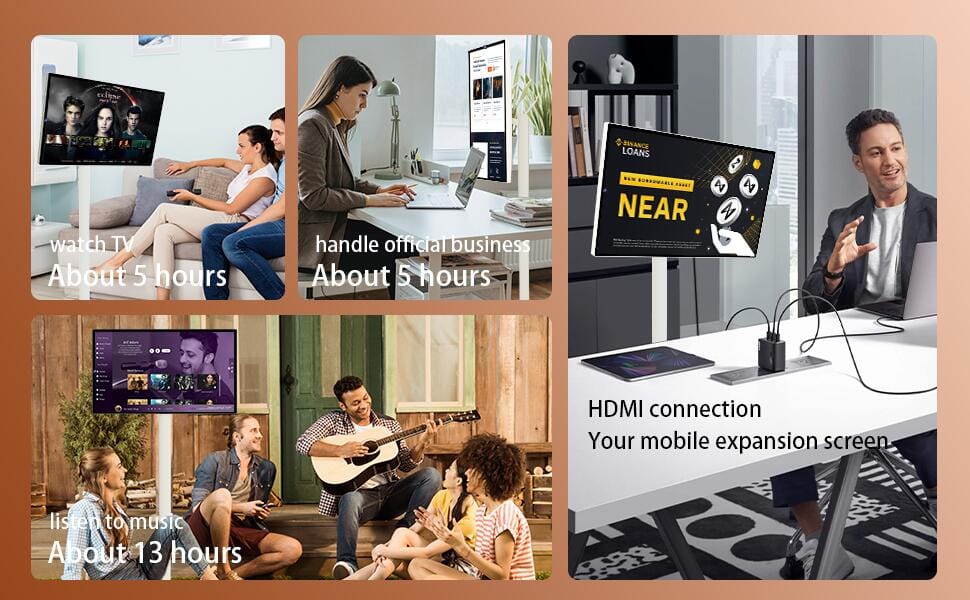
3. Seamless Connectivity Across Devices
With screen mirroring, you can effortlessly connect your device to a TV, projector, or monitor, making it easier to switch between personal, work, and entertainment uses. This creates a unified, smooth experience that saves time and effort:
- Cross-device functionality:You can control and interact with your device from the larger display,allowing for seamless multotasking.
- No file transfers required:There’s no need to transfer files or use external devices—everything can be managed directly from your smartphone.
4. Increased Accessibility
Screen mirroring also provides improved accessibility options for individuals with visual impairments. The larger screen size allows users to better see and interact with their device’s content, making tasks such as reading, watching videos, or browsing the web easier.
How to Connect Your Phone to a TV
Now that you understand the methods and benefits of screen mirroring, let’s look at the practical steps to connect your phone to a TV. We’ll walk you through both wireless and wired options.
1. Wireless Connection (For iOS & Android Devices)
Using AirPlay (for iPhone & iPad):
•Ensure your devices are connected to the same Wi-Fi: Make sure your iPhone/iPad and the TV (or Apple TV) are on the same Wi-Fi network.
•Open the Control Center: On your iPhone, swipe down from the upper-right corner to open the Control Center.
•Select “Screen Mirroring”: Tap the “Screen Mirroring” button and choose your TV or Apple TV from the list of available devices.
•Start Mirroring: Once connected, your phone’s screen will be displayed on your TV.
Using Chromecast (for Android and iOS Devices):
•Plug the Chromecast into your TV: Make sure your Chromecast is properly connected to your TV and powered on.
•Open a compatible app: Launch an app like YouTube, Netflix, or Google Photos, and look for the “Cast” icon.
•Select your Chromecast: Tap the Cast icon and select your Chromecast from the list of available devices.
•Start Casting: Your content will now appear on your TV.
2. Wired Connection (Using HDMI)
Using an HDMI Cable:
•Get an adapter: Depending on your phone (USB-C or Lightning for iPhones), you’ll need a compatible HDMI adapter.
•Connect the HDMI cable: Plug one end of the HDMI cable into your TV and the other end into the adapter.
•Connect your phone: Plug your phone into the adapter.
•Switch your TV input: Change your TV input to the correct HDMI channel to start screen mirroring.
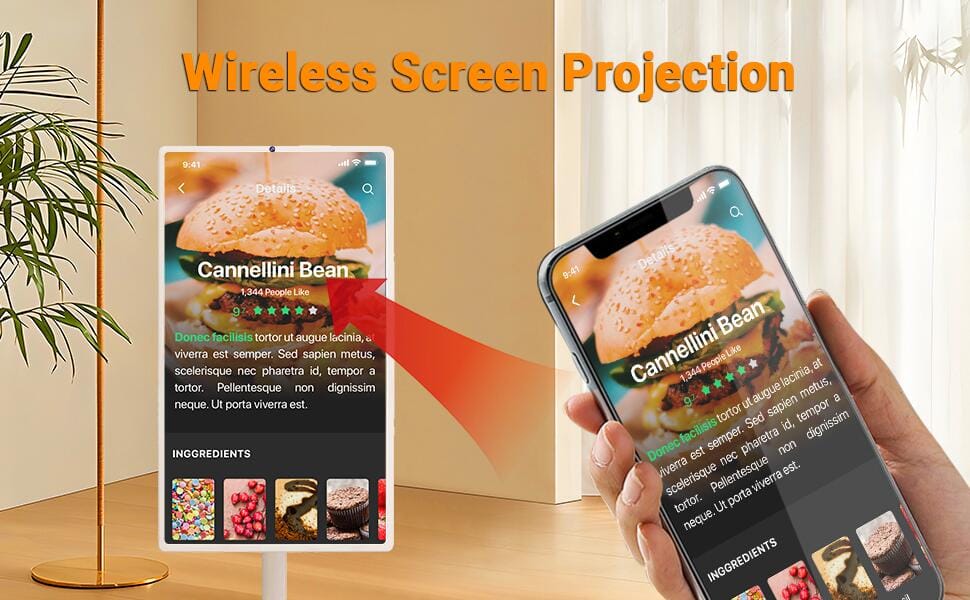
The Future of Screen Mirroring with Tablet on Wheels
With the rise of remote work, online learning, and interactive presentations, combining screen mirroring with a tablet on wheels is becoming a versatile and efficient solution. Whether you’re moving between classrooms, presenting in multiple conference rooms, or streaming content at home, this combination offers maximum flexibility.
Conclusion
Screen mirroring is an essential tool in our digital age, and by integrating it with a tablet on wheels, users can enjoy the ultimate convenience and flexibility. Whether you’re in education, business, or simply want to enhance your home entertainment setup, this combination of technologies can significantly improve your productivity and enjoyment.
Final Illustration: The Perfect Combination
A final illustration can depict all the elements coming together: a tablet on wheels in motion, various devices using screen mirroring (iPhone, Android, Windows, Mac), and different environments like classrooms, offices, and homes. This visual should reflect the seamless nature of combining a tablet on wheels with screen mirroring technology.
Tablet on wheels–Discount section
-
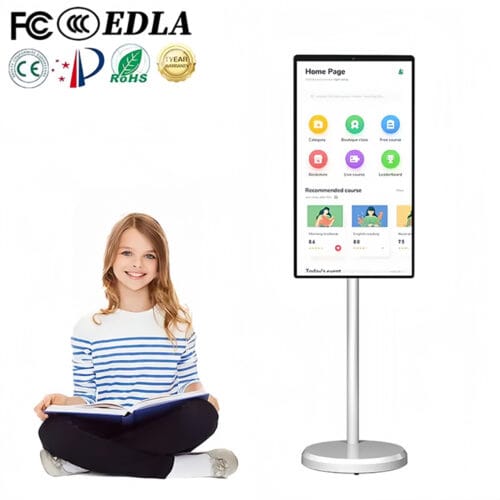 24 inch Stand By Me TV Movable Touch Television
24 inch Stand By Me TV Movable Touch Television -
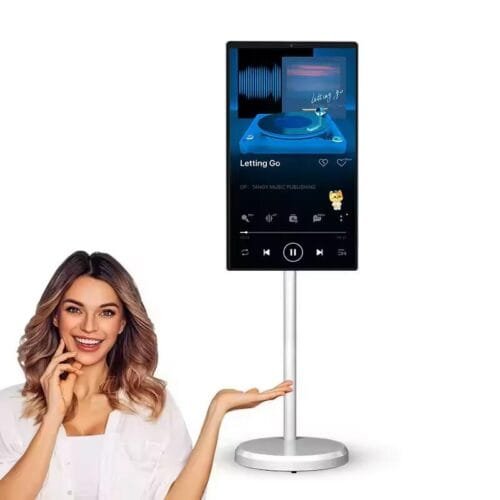 27-Inch Portable Tv Monitor On Wheels Touch Screen 1080p 64GB Storage Smart Screen,Portable Monitor Rotating Display With Mobile Base,With Built-in Battery ,Smart Monitor with Type-C Port
27-Inch Portable Tv Monitor On Wheels Touch Screen 1080p 64GB Storage Smart Screen,Portable Monitor Rotating Display With Mobile Base,With Built-in Battery ,Smart Monitor with Type-C Port -
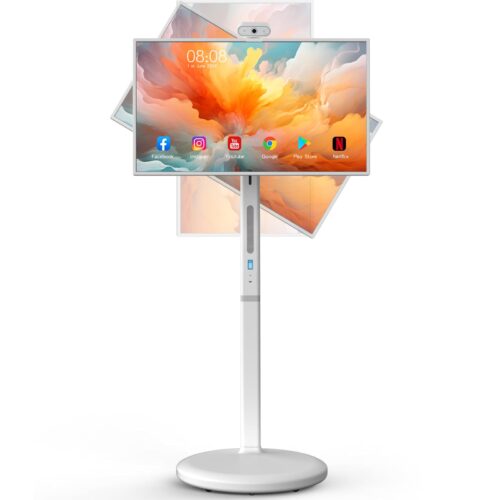 Portable Smart TV 32″ 1080P Touch Screen Monitor on Wheels, Android OS 13 Built-in Battery, Detachable Camera and Stand, Full Swivel Rotation Rolling Tablet for Kitchen, Bedroom, Outdoors
Portable Smart TV 32″ 1080P Touch Screen Monitor on Wheels, Android OS 13 Built-in Battery, Detachable Camera and Stand, Full Swivel Rotation Rolling Tablet for Kitchen, Bedroom, Outdoors -
 Stand by Me TV 21.5-Inch 1080P Portable TV on Wheels Touch Screen Monitor, Built in Battery, Full Swivel Rotation, Android12, 60Hz Refresh Rate
Stand by Me TV 21.5-Inch 1080P Portable TV on Wheels Touch Screen Monitor, Built in Battery, Full Swivel Rotation, Android12, 60Hz Refresh Rate